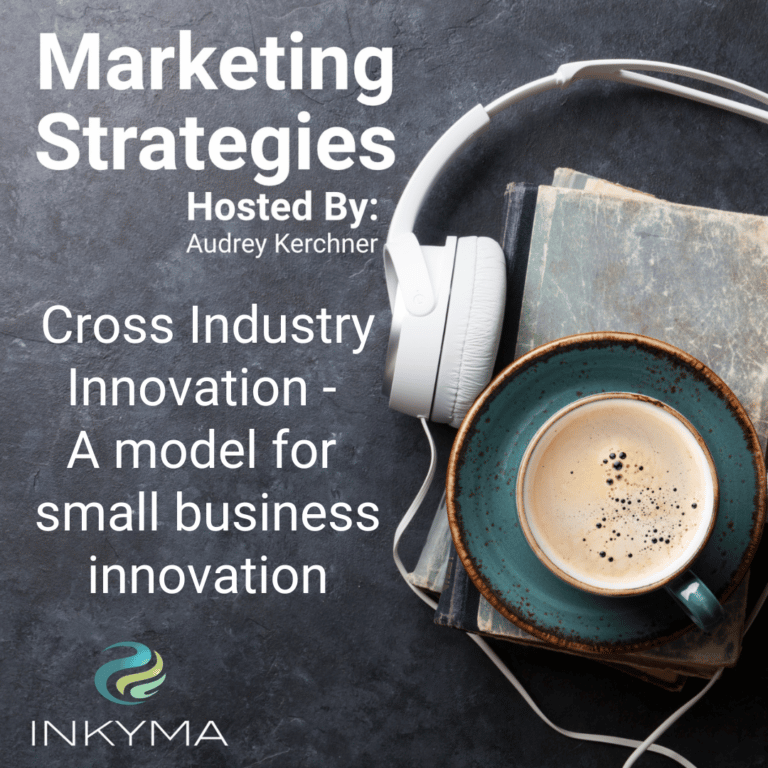Innovation is a big buzzword in the world of corporate business and fortune 500 but we don’t talk about it a lot in the world of small business owners. Small Business Innovation is something we as small business owners can do to differentiate our business, we don’t have to do things the way the competition does them.
One way to get new ideas and concepts for your small business innovation is to look at other industries and do cross-industry innovation. Today’s episode is going to introduce you to the concept of cross-industry innovation and how to use it for your small business innovation.
Links Mentioned In This Episode
Products We Recommend
The Book Of Beautiful Questions
Love our Podcast? Buy us a cup of coffee to help keep creating for you –
Check out our educational blog at marketingmasterminds.co free marketing educational content with how-to’s and training coming soon.
6 Types of business models/business designs
| Maker | Physical products, knowledge and time systems, certification /licensing systems |
| Channels | Niche retail or services (local small business); big spectrum retail or service (franchises or chain stores) |
| Crowd based | MLM’s (Arbonne) , membership clubs (Costco), crowdfunding (GoFundMe) |
| Payment | subscription-based (Netflix), replacement products (coffee, razors) |
| Exchange | buyer/seller marketplace (Etsy), transaction facilitator (Visa), Dynamic pricing (Uber) |
| Assets | Advertising (Google), reputation builders (Angie’s list, Trip advisor) |
What we discussed:
What is Cross Industry Innovation?
What questions can you ask yourself to start thinking like a Fortune 500 company?
Cross Industry Innovation – A model for small business innovation Transcript
What have I told you? Your next big business idea already exists, just not in your industry. because of this, no one else is doing it, and that’s why it is a big business idea. So today we are going to explore the concept of cross-industry innovation, where you can look at businesses and products and services outside of your own industry to figure out how to create a product, service, or revenue stream to differentiate your business and have more business growth.
So before I get into the meats and potatoes of the episode, just a bit of housekeeping stuff. I’m gonna talk about products, books, different things. And, there’s gonna be links in the show notes. So definitely go check the show notes, for this one. And then of course, the, show notes on the website.
We always have the rough transcript in there so you can go back and read it when you want. . when we talk about products and books and all these other kinds of things, we are usually partners with them because they are things that we use, in our business to market our clients. And so I pass that along.
We are affiliates with many of them, And we do appreciate if you use our links, if you’re going to, buy a product, a book, a service, or anything, because it just helps us out, right? It lets us, keep creating all this great, amazing content for you. Okay, so let’s start off with a question like I always do in, what is cross-industry innovation?
So this one is easy to explain, but it is a little more challenging to practice or figure out. It’s one of those ones where, the tip of the iceberg is maybe an inch, and then everything under the water, it just goes for miles and miles and miles. so the basic explanation. You look at other industries, see what they’re doing, and can you adapt it to do something totally new and different in your own industry.
there’s different ways to look at this or approach it. some approach it conservatively where, know, maybe they look just a couple industries over. So I’m a service based business. I’m gonna look at other service based businesses and see what they’re doing. And then others take it to.
Extremes, right? They look at things, that look totally ridiculous. It’s like I’m a service based business and I’m gonna look at,razor manufacturing and see what I can pull. So whether you go conservative or extreme, you definitely wanna do this. A lot of it depends on your personality and you know how deep in your business you are, how long you’ve been there, your depth of knowledge.
It’s gonna give you your comfort level of how wide and deep you go with this type of a concept. So go where you’re comfortable, right? That’s gonna be the underlying theme. when I, move into the next section here, So I wanna talk about business models, business design, business methodology, So you have industry categories, I’m a service based business and I’m an electrician. but what I wanna talk about our business models, How do you charge for those services? What do they look like? And so there’s six different types and within those types, there’s a lot, of different options to choose.
So one model is, a maker model, right? You make things those making of things could be physical products, Razors, shoes, coffee, glassware, homeware. and then there’s knowledge and time systems that you can make, right? So things like your CRM system, Many businesses out there use a CRM system.
Maybe they use a scheduling software. A lot of technology companies. Are actually just makers, right? So knowledge and time systems, Knowledge being, I can share my knowledge and I can charge a service. And another one is certification and licensing systems. Many of you out there require certification and or licensing to do your job, and there is a organization that provides that.
And that organization may charge you, an annual fee. You might have to take CEUs and you might have to pay for those ceu That is actually part of the maker business. . Then there’s the channels model, right? And a lot of us fall into this. We just don’t realize it. We’re in our channel, we’re in our swim lane.
So there’s niche retail and service type businesses. These are predominantly where a lot of your local small businesses fall into. I am a shop, I am a cafe, I am a bakery, service based business. I have a sprinkler system. I have pet care. I’m a chiropractor. And then you have the big spectrum retail or service businesses.
This is where your franchises come in or your chain stores. So think of companies like Walmart, or Papa John’s Pizza, right? that kind of a model. The next model is crowd based, which we’re all familiar with, but maybe we don’t think of it all as being like crowd, which is bringing people together under an umbrella, and self-identifying that way.
So,multi-level marketing companies are crowd based, meaning we’re all selling the same thing, but we’re doing it as a team. Basically creating sales forces there, membership clubs, things like Costco or Book of the month clubs or, those type of things. Or even like Audible, where you’re paying a subscription fee and then you’re paying more into it.
and then of course the first thing that people think of when I say crowd is crowdfunding. Like, GoFund. , which is also applicable here. payment models, right? This is, another category. a business model. You have subscription based payment models. first thing that comes to mind is Netflix. A lot of us use it.
We pay for it, we consume it, but we don’t own it. And then, replacement products you can do, coffee razors,massages, right? Once you’re done with the massage, you feel great, but you need another one. replacement products and then the exchange model. Is a good one too. buyer and seller marketplaces.
Things like Etsy, transaction facilitators, Visa, MasterCard, PayPal. You can buy things using their service. and then you can also collect payment from people using their service. And then another exchange model is dynamic pricing, such as Uber, right? Y every Uber you take is not gonna be the same. It depends on where you are, how far you have to go.
There’s a bunch of factors. There’s not just this flat fee that, every uber costs the same. but wouldn’t that be interesting? Okay,we’ll shelf that concept for another day. and then the last one, number six, is the assets model. , you have an asset and that’s what you’re selling.
So advertising is an asset model type of business. Google, one of their biggest revenue generators is,advertising. So small businesses can sign up and use that platform to advertise to billions of people, and they get a cut. another one is reputation builders. Things like when, Angie’s List for, um, Trade Guys or Trip Advisor for retail businesses such as, restaurants and hotels, to help people find you the list of these six models are in the show notes.
I would definitely go and grab it, take it, throw it into a Word document. Cuz the way I want you to think about these is don’t pick a swim lane. Don’t say I’m this. I’m that what I want you to do is think of this as a Chinese food menu, and I want you to pick what most appeals to you and what’s gonna work for your business, whether you’re doing it now or not.
you can pick some things, from that maker concept and then payment and then exchange, and then you can create a very unique business model, for your business off of that.
So I wanna share an example of a cross innovation with you. I,I did a quick exercise, on paper in my head, and this is what I came up with. So I started with Netflix, right? What is Netflix? It’s a subscription model company. that’s one of their models is their payment methodology, monthly fee, and.
Their platform is, it’s self-regulated. We sign up, we get access, we have 24 hour access, and we can watch whatever we want for however long we want. their big thing is they just gotta keep providing the content. If they want us to keep paying, they’ve gotta provide something, that we want to consume, which is the content.
So the business idea I came up with is, What if I owned a restaurant space, right? It’s got a kitchen, it’s got a wait service area. It’s got a place for tables and chairs, so you can sit down and you can eat, a restaurant, but instead of opening a restaurant, right? what if I created a subscription service?
for usage of this space that’s b2b. For other people that, make food, sell food, whether it’s online, in person for an event and they can, use an online scheduling system to schedule a time to use the kitchen a. do what they need to do and or the front of the house, right? They can, be two different systems.
I just want the front of the house for an event. I want the back of the house so I can cook something or bake something for my business, or I could do both. Maybe I wanna be a, remote catering company, but I also wanna offer a facility and not own the facility. . So you charge that fee, and they come in and use it.
It’s a really low cost of entry in this industry cuz if anybody’s been in, in restaurant and food service, the cost of entry is so high and it takes so long for you to make money because of that. so this is a really great alternative for that. Or even owning a food truck, right? There’s even still a significant investment in that.
so your job here, Is to offer that. Make it easy. Let them come and go. Don’t regulate it too much. you got a set of rules, they stick within those parameters and you keep the facility stopped with the right tools for what they’re trying to do. you’re not providing the.
Food, but the kitchen is fully stocked. The dining area has everything you need, in order to have an event or to have people come in. And then you can even have an add-on service that they can buy when they need to for a food delivery and purchase from preferred vendors that you’ve negotiated pricing with.
and the question that I started with here is how can I take the Netflix model of self-regulation and use it in the food industry? I was just playing around with it. so I think it’s a pretty cool idea. just gives you an idea how that cross innovation can work. and if you noticed, What I did is I started with a question.
I took some things and then I asked a question, and really, innovation or cross innovation is all about the questions. So when we’re doing cross innovation like this, it’s really an exercise in perception change and a little mental jujitsu going on there. And the best way to become more mentally flexible is to ask questions without trying to immediate.
Answer those questions. That’s where we fall down. We ask a question and then we’re like, Oh, we gotta solve this. We gotta answer it. No, no, no, no, no. The purpose here is not to immediately ask, answer the question. It’s actually to ask more questions. So Einstein is quoted as having said, If I had an hour to solve a problem, I’d spend 55 minutes thinking about that problem, and five minutes thinking about the solutions asking questions is think.
I put a link in the show notes to a book that I really love and enjoy and, I, try to reread often when I can. It’s called, the Book of Beautiful Questions, and it talks about the concept of asking more questions in general, but specifically towards business innovation. So now I have a little exercise or question, for you, right?
I came up with an idea, just off the cuff. It was fun, it was playful. Kind of got my mental jujitsu going on. so here’s one for you. So let’s start with Apple. Whether you love Apple or you hate Apple, we all know Apple. probably one of the biggest companies on the. . And so they make products, right?
They make phones, they make computers, they make tablets. but they also make all of the accessories for those products. Like when a product comes out, the accessories are like right there with it. and they’re usually very good, right? Probably better than the aftermarket stuff. And we know that they always work.
So things like the Apple pencil, cases, keyboards, mouse, they don’t just make a product. they build a suite. So here’s my question for you, given that scenario is what accessories or add-ons can you make or sell for your products or even for your services that you provide? So stop, don’t answer that question, right?
What I want you to do is ask more questions, right? What would the client. , why would they buy from me? Why would they buy that accessory from me? What are the benefits? do I have to make it or can I buy it from someone else? can I wrap a monthly service charge around it? What I want you to do is based off that initial question I asked you, don’t answer it, fill a page full of other questions around the entire concept.
That’s how you wanna think about cross innovation. it’s a little bit simplistic, but I think it’s gonna work without having to like, get a degree in cross company innovation. So we come to the part of the podcast where, I give you some action steps to take so you can utilize the things that we’ve talked about.
so I still wanna do that here, and I think it’s again, still gonna be more conceptual. but pick an industry that’s not your own. That’s the first thing I want you to do. I suggest you pick something that you like, that you know you could spend some time researching, looking at reading articles, so you don’t bore yourself to tears, right?
analyze them like they are actually one of your competitors. How many of us. I’m raising my hand, have stalked people in our industry just to see what they’re doing. I always look at them to see not only what are they doing well, but what are they not doing well? where can I like shimmy in there a little bit.
then I want you to ask yourself a lot of questions about who they are. What they do and what you think they do well, and what they don’t do well, What’s their business model, right? Try to stack them up against those six different, business category models that I talked about earlier in the episode.
How do they make money? if it’s something that’s a little conceptual, it looks like it’s all free, how are they making money? who are their clients? Are they similar to yours? Are they different from yours? What makes them success? , what makes them unsuccessful? If you’re looking at someone who’s not doing so great, how do they come up with their business model?
a lot of the bigger companies, corporations out there and Fortune 500 companies, they have a lot of articles written about them, even if they’re a mid-size company. just because people like to analyze and see, what did they do to get to where they. So as you’re asking these questions and you are analyzing these stuff, if you come up with ideas, just jot them down, right?
but don’t dive down the rabbit hole yet. I want you to make a list, but I want you to keep going with the questions. from this analysis, you create a full page of questions,for you to think about and then, Look at all the stuff that you jotted down and make questions about those, right?
Question these ideas that you had before. , you decide to say, Okay, I’m gonna try this, right? Because you may come up with more than one thing to try, and then you might have to prioritize these different things to try. but you’re not hanging your hat on one thing. And more importantly, you’re not just stopping at that one thing because it could be the third thing, the fifth thing, the 10th thing.
That’s the real magic that’s, going to take your company to the next level. So I would love to hear some of the ideas that you come up with from these exercises. You can either, send me an email, from the comment section of the website, or if you’re, listening to this on YouTube, put a comment, in the video, area.
you don’t have to give details if you don’t want to. but I would love to hear them. as part of. So here are my final thoughts for you. This is a big concept, and I feel like I just pointed at the iceberg for you. we didn’t even approach it. so I’m probably gonna do a couple more episodes around this, these exercises, that kind of thing to help you dive a little.
Deeper into this subject, because this type of thinking and doing is pretty mainstream, not pretty mainstream, but it’s well known in the Fortune 500 industry, in these millions and billions of dollars of companies. And they spend a lot of money on it, but we don’t talk about it a lot in small business.
And we should be, we should be talking about cross-industry innovations within the small business community. And so I wanna start changing that. I want us to start having more of those conversations. So break out of your lane and start thinking like a Fortune 500 company. Look at the competitors, look at other industries, and see what they’re doing.
this is one of the things that we do when we start working with a new client, is we try to help them start thinking differently about their customers, their industry, their business. . And then if we do figure out something that they wanna do differently and implement it, then we help them market it correctly in accordance with their brand and how they do all those things.
So this is actually something that I just love to do. so if you want to schedule some time with me to talk about your business, talk about, innovation,it would be great to do that. . So here at Inma we love to give back to the business community. I provide a 45 minute free consultation. and that’s for you to talk about whatever you want.
If you wanna talk about a, cross industry innovation you’re thinking about, we can spend 45 minutes on that. If you wanna talk about us doing your website, we can talk about that. It’s your 45 minutes for you to get whatever you. If you just have a comment, you wanna share something that you came up with, definitely go to the website, inma.com.
The schedule A session button is there, and also the contact form is there. So you can fill it out, share your comment with me. I’d love to read it. We also have all this great material that you can read through and share with other business owners. in addition to this podcast, we have the Marketing Masterminds blog, where we write articles, we create videos on how to use tools.
We’re gonna be doing more,visually, stimulating, concepts around stuff like this, cuz I know audio is limiting. So yeah, we’re thinking of big things over there. So hopefully you found this episode useful and helpful to you if you did. I know, you know, other small business owners that could probably listen to this.
Or need to listen to this as well. So consider sharing it. send the link in an email, point ’em to our website, point ’em to our YouTube channel. just get ’em there because the reason we do this is to help all small businesses grow and help the entire community grow. And we need your help doing that.
And by sharing the content, you’re helping all small businesses. So thanks so much for listening and I hope you have an amazing day.



























